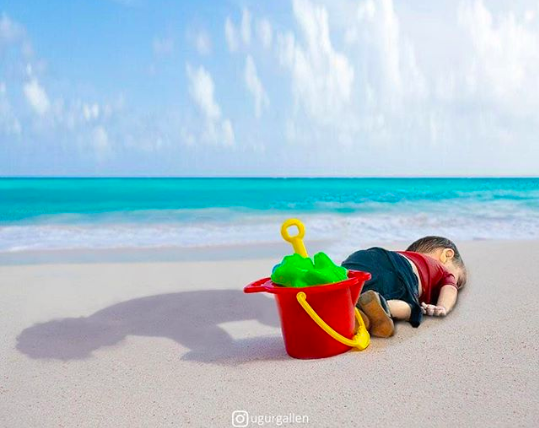Turkish artist, Uğur Gallenkuş, raises awareness of a “parallel world” with his collages.
-

Soldiers/Roadtrippers
Photo Credit: Uğur GallenkuşThe stark contrast between the experiences of individuals is a concept that is easy to grasp but hard to understand. Turkish artist, Uğur Gallenkuş’ work acts to highlight the differences between the first world and the third world with his collages.
I would like to tell the world that people in developing countries live in war, hunger and pain. If we want to live in peace and harmony we must have knowledge about each others’ lives.
–Uğur Gallenkuş to Agence France-Presse
The project begun in 2016 when Gallenkuş went viral with his reimagining of the infamous photo of a drowned Aylan Kurdi. The image of three-year-old Kurdi had sent shock waves through many, humanising the refugee crisis for many who were not educated on the matter. The Kurdi family had been trying to make their way to Canada from Syria to meet one of their eldest daughters, who had found refuge in Vancouver over the last two decades. Their ship had capsized and, in the aftermath,, Abdullah Kurdi, Aylan’s father, had been the only survivor. His wife and two sons had both drowned.

Uğur Gallenkuş’ rendition of Aylan Kurdi
Photo Credit: Uğur GallenkuşGallenkuş’ work attempts to maintain the impact that this photo had had on the world. He takes images of wartorn countries and juxtaposes them with stock images. Children participating in sport in Western countries paired with the image of a child soldier. An image of two people kissing spliced with a boy in Sudan drinking from the Akuem River. Each piece is accompanied with an explanation of the story behind the image, highlighting its importance.
Gallenkuş’ covers many different topics, highlighting the occurrence of war, famine, domestic violence, income inequality and climate change. However, he has stated that his focus mainly lies in the terrors of war occurring in Iraq, Syria and Afghanistan.
Below are a selection of Gallenkuş’ most striking pieces because, as in his own words:
“An image can sometimes be more effective than a thousand words. Many complicated words can describe the solution to a crisis, but you don’t need to know a language to read and understand a work of art.”
Please be aware that some images may be distressing to view.
Subscribe to FIB’s newsletter for your weekly dose of music, fashion and pop culture news!






